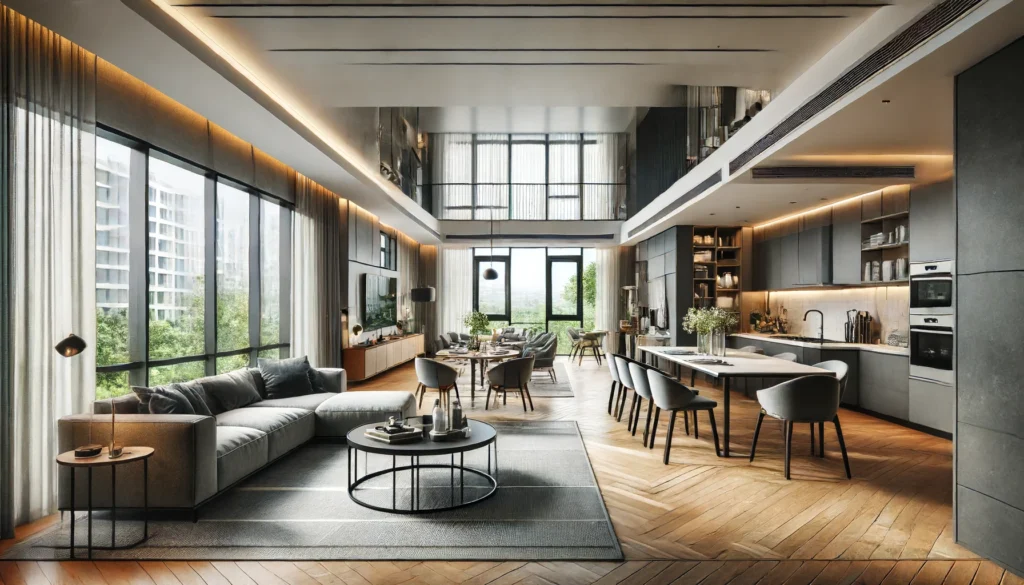Top Home Design Trends and Tips for 2024
Transform Your Living Space
Home design is an ever-evolving field, reflecting lifestyle, technology, and aesthetic changes.
As we enter 2024, new trends promise to transform our living spaces into more stylish, functional, and sustainable environments.
Whether planning a complete renovation or just looking to update a room or two, this guide will provide you with the top home design trends and practical tips to make your home beautiful and livable.
Embrace Sustainable Design
Sustainability continues to be a significant focus in home design. Here are some ways to incorporate eco-friendly elements into your home:
- Eco-friendly Materials: Use recycled, reclaimed, and sustainably sourced materials for flooring, furniture, and decor.
- Energy-efficient Appliances: Upgrade to energy-efficient appliances to reduce your carbon footprint and save on utility bills.
- Indoor Plants: Incorporate indoor plants to improve air quality and bring a touch of nature indoors.
Sustainability in Home Design: Eco-Friendly Elements for Your Home
Sustainability continues to be a significant focus in home design. Here are some ways to incorporate eco-friendly elements into your home:
1. Use Recycled and Reclaimed Materials
Incorporate recycled and reclaimed materials for various home elements, such as flooring, furniture, and decor.
These materials reduce waste and add unique character and charm to your space.2. Opt for Energy-Efficient Appliances
Upgrade to energy-efficient appliances, which consume less energy and water. Look for appliances with ENERGY STAR ratings, which ensure they meet high-efficiency standards.
3. Install Solar Panels
Solar panels can significantly reduce reliance on traditional energy sources, lowering your electricity bills and carbon footprint.
They are a long-term investment that pays off both financially and environmentally.4. Use Low-VOC Paints and Finishes
Volatile Organic Compounds (VOCs) in paints and finishes can contribute to indoor air pollution.
Opt for low-VOC or VOC-free paints and finishes to improve indoor air quality and create a healthier living environment.5. Invest in Insulation
Proper insulation can reduce your heating and cooling needs, making your home more energy-efficient.
Consider eco-friendly insulation materials like recycled denim, sheep’s wool, or cellulose made from recycled paper.6. Install Energy-Efficient Windows
Energy-efficient windows help maintain a consistent indoor temperature, reducing the need for heating and cooling.
Double or triple-glazed windows with low-emissivity (Low-E) coatings are excellent options.7. Harvest Rainwater
Install rainwater harvesting systems to collect and store rainwater for irrigation, flushing toilets, or washing clothes.
This practice conserves water and reduces your utility bills.8. Use Natural and Sustainable Flooring
Choose flooring materials that are renewable and have a low environmental impact.
Bamboo, cork, and sustainably harvested wood are excellent, stylish, and eco-friendly options.9. Incorporate Indoor Plants
Indoor plants not only enhance the aesthetic appeal of your home but also improve air quality by absorbing pollutants and releasing oxygen.
Choose low-maintenance plants like snake plants, pothos, or succulents.10. Implement Smart Home Technology
Smart home technology can help you monitor and reduce energy usage. Install smart thermostats, lighting, and appliances that can be controlled remotely and programmed to operate more efficiently.
11. Utilize Natural Lighting
Maximize natural lighting to reduce the need for artificial lighting during the day. Large windows, skylights, and open floor plans can help bring more sunlight into your home, creating a bright and energy-efficient space.
12. Choose Eco-Friendly Textiles
Select textiles made from natural, organic, or recycled fibers for your curtains, upholstery, and bedding.
Organic cotton, linen, and hemp are sustainable choices that are also durable and comfortable.13. Implement a Composting System
Set up a composting system for your kitchen and garden waste. Composting reduces landfill waste and provides nutrient-rich soil for your garden.
14. Install Water-Saving Fixtures
Water-saving fixtures like low-flow toilets, faucets, and showerheads can significantly reduce water consumption.
These fixtures are designed to provide the same level of performance while using less water.
Open Floor Plans Home Design 2024
Open floor plans remain popular in home design, as they create a sense of spaciousness and allow for better flow between different home areas.
This design concept involves removing walls and barriers to combine common areas like the kitchen, dining room, and living room into a cohesive space.
Here are some benefits and tips for implementing an open floor plan in your home:
Benefits of Open Floor Plans
- Increased Natural Light: With fewer walls blocking the flow of light, open floor plans allow natural light to permeate the space, making it feel brighter and more inviting.
- Enhanced Social Interaction: Open spaces facilitate more accessible communication and interaction among family members and guests, making them ideal for entertaining and family gatherings.
- Flexibility in Layout: The lack of walls provides greater flexibility in arranging furniture and defining spaces, allowing you to adapt the layout to your needs.
- Improved Aesthetics: An open floor plan can make your home look more modern and stylish by creating a seamless transition between different functional areas.

Tips for Designing an Open Floor Plan
- Create Zones: Use furniture, rugs, and lighting to create distinct zones within the open space. For example, a sectional sofa can define the living area, while a dining table and pendant light can highlight the dining area.
- Consistent Design Elements: Maintain a cohesive look using consistent design elements like color schemes, flooring, and materials throughout the open space.
- Maximize Storage: Incorporate built-in solutions to keep the open space clutter-free and organized. Kitchen islands with storage, built-in shelves, and multifunctional furniture can help maximize space.
- Consider Acoustics: Open spaces can sometimes amplify noise. Use area rugs, curtains, and upholstered furniture to help absorb sound and create a more comfortable environment.
Multifunctional Spaces
Multifunctional spaces are gaining traction, especially in smaller homes where every square foot counts.
These spaces are designed to serve multiple purposes, making them highly efficient and adaptable. Here are some ideas for creating multifunctional spaces in your home:
Ideas for Multifunctional Spaces
- Home Office and Guest Room: Combine a home office with a guest room by using a desk that can be easily folded away or incorporating a Murphy bed that folds into the wall when not in use.
- Living Room and Play Area: Create a play area for children within the living room by using modular furniture that can be easily rearranged. Storage ottomans and bins can keep toys organized and out of sight.
- Dining Room and Workspace: Use a large dining table as a workspace during the day. Add comfortable chairs and good lighting to make it functional office space.
- Bedroom and Exercise Area: Incorporate an exercise area in the bedroom by using foldable or compact fitness equipment that can be stored away when not in use.
Benefits of Multifunctional Spaces
- Maximized Space Utilization: Multifunctional spaces allow you to make the most of every square foot, making them ideal for tiny homes or apartments.
- Cost-Effective: Combining multiple functions into one space can save money on additional furniture and renovations.
- Flexibility: These spaces can be easily adapted to changing needs, making your home more versatile and accommodating.
- Enhanced Lifestyle: By creating multifunctional spaces, you can seamlessly integrate work, leisure, and daily activities into your home, enhancing your overall lifestyle.
Smart Home Technology: Enhancing Your Living Space with Innovation
Smart home technology is revolutionizing our lives, making our homes more convenient, secure, and energy-efficient.
From voice-activated assistants to automated lighting systems, these innovations can transform your living space into a modern, efficient, and comfortable environment.
This guide will explore the latest smart home technologies and how they can enhance your daily life.
Benefits of Smart Home Technology
- Convenience: Automate everyday tasks and control your home with a simple voice command or tap on your smartphone.
- Energy Efficiency: Smart devices can help you monitor and reduce energy consumption, leading to lower utility bills.
- Security: Enhance your home security with smart locks, cameras, and alarms that provide real-time alerts and remote access.
- Comfort: Create a comfortable living environment with smart thermostats, lighting, and entertainment systems tailored to your preferences.
Popular Smart Home Devices
1. Smart Speakers and Voice Assistants
- Devices: Amazon Echo, Google Home, Apple HomePod
- Features: These devices can control other smart home gadgets, answer questions, play music, and manage your daily schedule through voice commands.
2. Smart Lighting
- Devices: Philips Hue, LIFX, TP-Link Kasa
- Features: Control your lighting remotely, set schedules, and adjust brightness and color to create the perfect ambiance for any occasion.
3. Smart Thermostats
- Devices: Nest Learning Thermostat, Ecobee, Honeywell Home
- Features: These thermostats learn your schedule and preferences to optimize heating and cooling, saving energy and enhancing comfort.
4. Smart Security Systems
- Devices: Ring Alarm, Arlo Pro, SimpliSafe
- Features: Monitor your home with security cameras, motion sensors, and smart locks. Receive real-time alerts and control your system remotely.
5. Smart Appliances
- Devices: Samsung Family Hub Refrigerator, LG Smart Washer, Roomba Robot Vacuum
- Features: Manage your kitchen, laundry, and cleaning tasks more efficiently with appliances that can be controlled and monitored via smartphone apps.
6. Smart Plugs and Outlets
- Devices: Wemo Mini Smart Plug, TP-Link Kasa Smart Plug, Amazon Smart Plug
- Features: Turn any standard appliance into a smart device by plugging it into a smart plug, allowing remote control and automation.
Integrating Smart Home Design 2024
1. Create a Central Hub
- Smart Home Platforms: Amazon Alexa, Google Assistant, Apple HomeKit
- Benefits: A central hub allows you to control all your smart devices from one interface, providing seamless integration and ease of use.
2. Prioritize Security
- Best Practices: Ensure your smart devices are secure by using strong passwords, enabling two-factor authentication, and updating firmware.
3. Start Small
- Tips: Begin with a few essential devices and gradually expand your smart home system as you become more comfortable with the technology.
4. Compatibility
- Advice: Choose devices compatible with each other and your central hub to avoid integration issues.
5. Professional Installation
- Option: Consider professional installation for complex systems like security and HVAC to ensure everything is set up correctly and functions smoothly.
Future Trends in Smart Home Technology
- Artificial Intelligence (AI): AI-powered devices will become more intuitive, learning from your habits to provide personalized experiences.
- Interconnectivity: Increased compatibility between brands and devices will simplify smart home integration.
- Sustainability: Smart home technology will continue to focus on energy efficiency and sustainability, offering more eco-friendly solutions.
- Health Monitoring: Innovations in smart home tech will include health monitoring features, such as air quality sensors and fitness tracking.
Conclusion
Smart home technology offers numerous benefits that can enhance your lifestyle by making your home more convenient, secure, and energy-efficient.
By incorporating smart speakers, lighting, thermostats, security systems, appliances, and plugs, you can create a modern living space tailored to your needs. Stay ahead of the curve by monitoring future trends and gradually integrating smart technology into your home for a more connected and efficient life.






